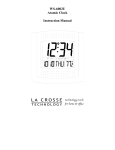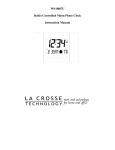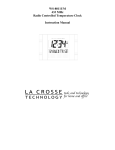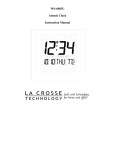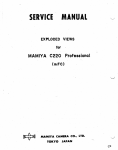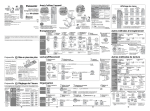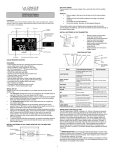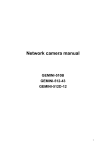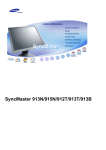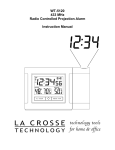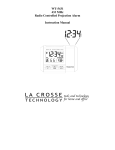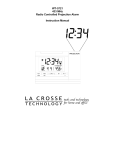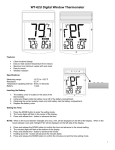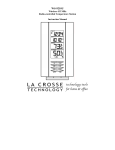Download La Crosse Technology WS-8056U User's Manual
Transcript
WS-8056U 433 MHz Radio Controlled Temperature Alarm Instruction Manual TABLE OF CONTENTS Topic Inventory of Contents/ Additional Equipment About WWVB Quick Set-Up Guide Detailed Set-Up Guide Battery Installation Program Mode Function Buttons Time Zone Setting DST (Daylight Saving Time) Setting Language Selection Time Setting Calendar Setting 12/24-Hour Setting Selecting °F or °C Features & Operations Changing Display Mode (viewing seconds) The Alarm Indoor temperature Remote Temperature Mounting Maintenance & Care Troubleshooting Specifications Warranty Information 2 Page 3 3 4 5 6 6 7 7 7 8 8 8 9 10 11 11 11 12 13 14 15-16 INVENTORY OF CONTENTS 1) WS-8056U 2) TX6U remote temperature transmitter 3) Instruction manual and warranty card. ADDITIONAL EQUIPMENT (not included) 1) 2) 3) 4) Two fresh 1.5V AA batteries. Two fresh 1.5V AA batteries. Three wall-hanging screws. Appropriate screwdriver for screws. ABOUT WWVB (Radio Controlled Time) The NIST (National Institute of Standards and Technology—Time and Frequency Division) WWVB radio station is located in Ft. Collins, Colorado, and transmits the exact time signal continuously throughout the United States at 60 kHz. The signal can be received up to 2, 000 miles away through the internal antenna in the Temperature Alarm. However, due to the nature of the Earth’s Ionosphere, reception is very limited during daylight hours. The Temperature Alarm will search for a signal every night when reception is best. The WWVB radio station derives its signal from the NIST Atomic clock in Boulder, Colorado. A team of atomic physicists is continually measuring every second, of every day, to an accuracy of ten billionths of a second per day. These physicists have created an international standard, measuring a second as 9,192,631,770 vibrations of a Cesium-133 atom in a vacuum. 3 QUICK SET-UP GUIDE Hint: Use good quality Alkaline Batteries and avoid rechargeable batteries. 1. 2. 3. 4. Have the temperature clock and remote temperature sensor 3 to 5 apart. Batteries should be out of both units for 10 minutes. Place the batteries into the remote temperature sensor first then into the temperature clock. (All remote temperature sensors must be started before the temperature clock) DO NOT PRESS ANY BUTTONS FOR 10 MINUTES. In this time the temperature clock and remote temperature sensor will start to talk to each other and the temperature clock will show both the indoor temperature and an outdoor temperature. If the temperature clock does not display both temperatures after the 10 minutes please retry the set up as stated above. After both indoor and outdoor temperatures are displayed for 10 minutes you can place your remote temperature sensor outdoors and set your time. The remote temperature sensor should be placed in a dry, shaded area. The remote temperature sensor has a range of 80 feet. Any walls that the signal will have to pass through will reduce distance. An outdoor wall or window will have 20 to 30 feet of resistance and an interior wall will have 10 to 20 feet of resistance. Your distance plus resistance should not exceed 80 ft. in a straight line. NOTE: Fog and mist will not harm your remote temperature sensor but direct rain must be avoided. To complete the set up of your temperature clock after the 10 minutes have passed please follow the steps below. 4 DETAILED SET-UP GUIDE I) BATTERY INSTALLATION Note: To avoid start-up problems make sure that the batteries do not spring free. A) REMOTE TEMPERATURE SENSOR 1) Remove the battery cover. Place your thumb over the two air-vent slots on the face of the remote temperature sensor, push down gently, and slide battery cover down and off. 2) Observing the correct polarity, install 2 AA batteries. The batteries will fit tightly (to avoid start-up problems make sure that they do not spring free during installation). 3) Replace the battery cover. B) TEMPERATURE ALARM 1) Remove the battery cover, located on the backside of the unit and directly below the function buttons. 2) Observe the correct polarity and install 2 AA batteries. 3) Replace the battery cover. Note: After the batteries have been Radio reception installed a tone will sound, and all the LCD’s (Liquid Crystal Display) WWVB Alarm will briefly light up. The indoor temperature, the date as “1/ 1”, the Outdoor temperature Date weekday as “MON”, and the remote temperature will be displayed (within Indoor temperature or Weekday or seconds display seconds display three minutes). Also, the time will appear as “-:--” for approximately 1 minute. The WWVB search is automatically initiated, and a tower icon appears and flashes with the time colon (no tower icon will appear if the WWVB is too weak to be detected, and the time display will remain on “-:--”). While the WWVB search is being conducted various numbers will appear in the time display. After 10minutes, the temperature alarm will either display the WWVB time, or discontinue the search if the time is not found. If the search is cancelled “-:--” will appear in the time LCD. The temperature alarm will conduct a WWVB search every hour until the first signal is found. Once the WWVB time is found, a search is automatically conducted nightly at midnight. If the signal is found at midnight, the tower icon will remain, if not, another search will take place every hour (until 6:00 am) until the signal is found successfully. If no signal is found during this period, the tower icon will not appear and the clock will search again at 12:00 am the next night. 5 II) PROGRAM MODE To enter the program mode hold down the “SET” button for 2 seconds, until “-5EST” flashes in the date LCD. The program mode is laid out in a manner that allows you to program each function separately, or you can follow the instructions entirely to program the temperature alarm. Complete programming is usually done for the initial set-up, and will require you to skip step 1 of programming sections III through VIII. Press the “SNOOZE” button at any time to exit the program mode, or wait approximately 15 seconds for the temperature alarm to automatically return to normal operation. A) FUNCTION BUTTONS There are 3 function buttons located on the front of the temperature alarm and one on the top. The function buttons are labeled: “SET”, “+”, “ALARM”, and “SNOOZE” (the top bar). B) TIME ZONE SETTING 1) Hold down the “SET” button for 2 seconds, the default setting “-5EST” will flash in the date LCD. 2) Press and release the “+” button to select the appropriate time zone. There are 13 time zones to choose from: -4ATL -5EST -6CST -7MST -8PST -9ALA -10HAW -11, -12 GMT -1, -2, -3GMT Atlantic Time Eastern Time (default setting) Central Time Mountain Time Pacific Time Alaskan Time Hawaiian Time Next two time zones West of HAW Greenwich Mean Time Three time zones West of GMT 3) Press and release the “SET” button to confirm the time zone setting, and to advance to DST (Daylight saving time) setting. 6 C) DST (DAYLIGHT SAVING TIME) SETTING Note: The DST default is “On”, meaning that the WWVB will automatically change the time according to Daylight Saving Time in the spring and fall. For areas that do not recognize DST changes (Arizona and parts of Indiana) turn the DST “OFF”. 1) Hold down the “SET” button for 2 seconds (the selected time zone will flash); press and release the “SET” button once more until “On” flashes in the time LCD and “DST” flashes where the weekday normally appears. 2) Press and release the “+” button to turn the DST off, this will be indicated by the display of “OFF” in the time LCD. 3) Press and release the “SET” button to confirm the DST setting and to advance to select the language for the weekday. D) LANGUAGE SELECTION FOR THE WEEKDAY 1) Hold down the “SET” button for 2 seconds (the selected time zone will flash), press and release the “SET” button 2 more times until the default language “US” flashes in the time LCD. 2) Press and release the “+” button to toggle through and to select the desired language. There are 3 languages to select from: US F E English French Spanish Press and release the “SET” button to confirm the language setting, and to advance to manually set the time. E) TIME SETTING Note: When the WWVB signal is found, that time will over-ride the manually set time. 1) Hold down the “SET” button for 2 seconds (the selected time zone will flash), press and release the “SET” button 3 more times until the hour “12” flashes in the time LCD. 2) Press and release the “+” button to select the hour. Note: when setting the hour, “PM” will appear to the left of the hour display, if it is AM nothing will be displayed. 3) Press and release the “SET” button to confirm the hour setting, and to shift to select the minutes. 4) Press and release the “+” button to select the minutes. 5) Press and release the “SET” button to confirm the time setting, and to advance to manually set the calendar. 7 F) CALENDAR SETTING Note: When the WWVB signal is found, that date will over-ride the manually set date. 1) Hold down the “SET” button for 2 seconds (the selected time zone will flash), press and release the “SET” button 5 more times until the default year “00” flashes in the date LCD. 2) Press and release the “+” button to select the year. 3) Press and release the “SET” button to confirm the year and to move to select the month. 4) The default month “1” will flash. Press and release the “+” button to select the appropriate month. 5) Press and release the “SET” button to confirm the month and to move to select the date. 6) The default date “1” will flash. Press and release the “+” button to select the appropriate date. 7) Press and release the “SET” button to confirm the date and to move to select the weekday. 8) The default weekday “MON” (depends on selected language) will flash. Press and release the “+” button to select the appropriate weekday. 9) Press and release the “SET” button to confirm the calendar settings and to advance to select either 12 or 24-hour time display. G) 12/24-HOUR SETTING 1) Hold down the “SET” button for 2 seconds (the selected time zone will flash), press and release the “SET” button 9 more times until the “12” hour time display flashes in the time LCD. 2) Press and release the “+” button to toggle between 12 and 24 hour time. 3) Press and release the “SET” button to confirm the 12/24-hour time display and to advance to select either °F or °C. H) SELECTING °F OR °C 1) Hold down the “SET” button for 2 seconds (the selected time zone will flash), press and release the “SET” button 10 more times until the default “°F” flashes in the time LCD. 2) Press and release the “+” button to toggle between °F and °C. 3) Press and release the “SET” button to confirm the °F or °C selection and exit the Program Mode. 8 III) FEATURES & OPERATIONS A) CHANGING DISPLAY MODE (DAY, SECONDS, AND TEMPERATURE) There are three possible display modes to view the day, seconds, and temperature. The month&date/weekday /indoor temperature/remote temperature is the default. To change the display: 1) Press and release the “+” button. 2) The display should now show the month&date/seconds/indoor temperature/remote temperature 3) Press and release the “+” button a second time. 4) The display will now show the month&date/weekday/seconds/remote temperature 5) Press and release the “+” button a third time and the display will return to the normal display. 9 B) THE ALARM 1) SETTING THE ALARM Note: The duration of the alarm is 85 seconds. After each of the first two 25 second periods, the rate of the alarm increases. (a) Hold down the “ALARM” button for 5 seconds. The “TIME” icon to the right of the minutes (in the time LCD) shifts to “ALARM” and the hour digit of the alarm flashes. (b) Press and release the “+” button to set the alarm hour. (c) Press and release the “ALARM” button to confirm the hour and to set the alarm minutes. (d) The alarm minutes will now flash. (e) Press and release the “+” button to set the alarm minutes. (f) Press and release the “ALARM” button to confirm and to exit the alarm setting mode. Note: The alarm will be automatically set to sound when exiting the alarm-setting mode (indicated by the alarm “sound” icon to the right of the time). 2) ACTIVATING/DEACTIVATING THE ALARM (a) The alarm will be automatically set to sound when exiting the alarmsetting mode (indicated by the alarm “sound” icon to the right of the time). (b) Press and release the “ALARM” button to activate and deactivate the alarm. The alarm “sound” icon to the right of the time will appear or disappear and the alarm time will be displayed briefly before returning to the normal display mode. 3) ACTIVATING THE SNOOZE FUNCTION (a) While the alarm is sounding, press and release the “SNOOZE” button to activate the snooze function. The alarm “sound” icon and “SNOOZE” icon (to the right of the time) will flash. The duration of the snooze function is 10 minutes, then the alarm will resume. 4) SUSPENDING ALARM (a) While the alarm is sounding or the SNOOZE is active, press and release the “ALARM” button to suspend the alarm until the next day. 10 C) INDOOR TEMPERATURE The indoor temperature appears on the right side of the date LCD. The temperature is checked every 10 seconds and updated whenever there is a change. D) REMOTE TEMPERATURE The remote temperature will be shown on the right side of the lower LCD screen. The temperature alarm receives the outdoor temperature (°F or °C) from the remote temperature sensor, and the temperature appears in the outdoor LCD. The remote temperature sensor transmits a new temperature to the temperature alarm 3 times every 10 minutes. IV) MOUNTING THE REMOTE TEMPERATURE TRANSMITTER A) The remote temperature sensor can be mounted in two ways: 1) With the use of screws. 2) Using the adhesive tape. B) MOUNTING WITH SCREWS 1) Remove the mounting bracket from the remote temperature sensor. The bracket should snap off easily. 2) Place the mounting bracket over the desired location. Through the three screw holes of the bracket, mark the mounting surface with a pencil. 3) Where marked, start the screw holes into the mounting surface. 4) Screw the mounting bracket onto the mounting surface. Ensure that the screws are flush with the bracket. 5) Snap the remote temperature sensor onto the mounted bracket. C) MOUNTING WITH ADHESIVE TAPE 1) With a nonabrasive solution, clean and dry the back of the mounting bracket and the mounting surface to ensure a secure hold. The mounting surface should be smooth and flat. 2) Remove the protective strip from one side of the tape. 3) Adhere the tape to the designated area on the back of the mounting bracket. 4) Remove the protective strip from the other side of the tape. 5) Position the remote temperature sensor in the desired location, ensuring that the temperature alarm can receive the signal. 11 V) MAINTENANCE & CARE • • • • • Extreme temperatures, vibrations, and shock should be avoided to prevent damage to the units. Clean displays and units with a soft, damp cloth. Do not use solvents or scouring agents—they may mark and damage the displays and casings. Do not submerge in water. Immediately remove all low powered batteries to avoid leakage and damage. Replace with new batteries only, and of recommended size. Opening the casings invalidates the warranty. Do not try to repair the units. Contact La Crosse Technology for Repairs. 12 TROUBLESHOOTING The LCD is faint. Problem: 1) Replace the batteries. Solution: “OFL” appears in the indoor temperature LCD. Problem: 1) Move unit to an area with warmer or cooler surrounding Solution: temperature. Current surrounding temperatures are outside measuring range. No reception of WWVB signal. Problem: 1) It may help reception to face the front of the temperature Solution: alarm in the general direction of Ft. Collins, Colorado. 2) Wait overnight for signal. 3) Be sure the temperature alarm is at least 6 feet from any electrical devices, i.e. TV sets, computers, or other radio controlled clocks. 4) Remove batteries for five minutes, reinsert and leave the unit alone overnight without pressing buttons. 5) If problems persist contact La Crosse Technology. Hour is incorrect (minute and date are correct). Problem: 1) Be sure correct time zone and daylight saving time are Solution: selected. “--.-” appears in outdoor temperature LCD Problem: 1) Check batteries in remote Solution: 2) If batteries are replaced in remote, the unit must be re-started. Remove all batteries, and then follow start up procedure. “OFL” appears in the outdoor temperature LCD Problem: 1) Remote temperature is out of range. Solution: 2) Check batteries. 3) Interference from an outside source (cordless telephone, etc.) 4) Contact La Crosse Technology. Note: For any questions not answered, contact La Crosse Technology with the contact information found at the end of this instructional manual. 13 SPECIFICATIONS FOR WS-8056U Temperature: Measuring range: 32°F to 122°F with 0.2°F resolution (indoor) -21.8°F to 140°F with 0.2°F resolution (outdoor) (0°C to 50°C with 0.1°C resolution) Checking intervals: Every 10 seconds indoor, 3 times in 10 minutes for remote temperature. Power source: Battery type: Station: 2 x AA, 1.5V (Alkaline) Transmitter: 3 x AA, 1.5V (Alkaline) Battery life: Approximately 12 months Dimensions (L x W x H): Temperature alarm 4.50 x 2.00 x 3.75 in (118 x 50 x 98 mm) Remote temperature sensor 5.25 x 1.50 x 0.75 in (133 x 38 x 19 mm) 14 WARRANTY INFORMATION La Crosse Technology provides a 1-year warranty on this temperature alarm. Contact La Crosse Technology immediately upon discovery of any defects covered by this warranty. Before sending the temperature alarm in for repairs, contact La Crosse Technology. The temperature alarm will be repaired or replaced with the same or similar model. This warranty does not cover any defects resulting from improper use, unauthorized repairs, faulty batteries, or the temperature alarms inability to receive a signal due to any source of interference. LA CROSSE TECHNOLOGY WILL NOT ASSUME LIABILITY FOR INCIDENTAL, CONSEQUENTIAL, PUNITIVE, OR OTHER SIMILAR DAMAGES ASSOCIATED WITH THE OPERATION OR MALFUNCTION OF THIS TEMPERATURE ALARM. THIS PRODUCT IS NOT TO BE USED FOR MEDICAL PURPOSES OR FOR PUBLIC INFORMATION. THIS PRODUCT IS NOT A TOY. KEEP OUT OF CHILDRENS’ REACH. This warranty gives you specific legal rights. You may also have other rights specific to your State. Some States do not allow the exclusion of consequential or incidental damages; therefore the above exclusion of limitation may not apply to you. For warranty work, technical support, or information contact: La Crosse Technology, Ltd 2809 Losey Blvd. S. La Crosse, WI 54601 Phone: 608.782.1610 Fax: 608.796.1020 e-mail: [email protected] (warranty work) [email protected] (information on other products) web: www.lacrossetechnology.com 15 FCC ID: OMO-01RX (receiver) THIS DEVICE COMPLIES WITH PART 15 OF THE FCC RULES. OPERATION IS SUBJECT TO THE FOLLOWING TWO CONDITIONS: 1. THIS DEVICE MAY NOT CAUSE HARMFUL INTERFERENCE, AND 2. THIS DEVICE MUST ACCEPT INTERFERENCE RECEIVED, INCLUDING INTERFERENCE THAT MAY CAUSE UNDESIRED OPERATION. 16
















